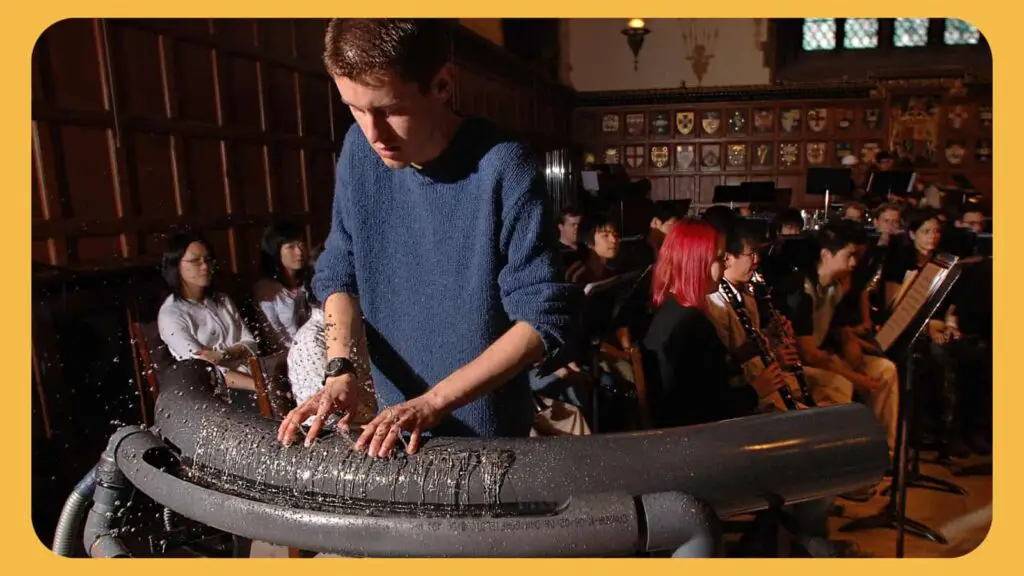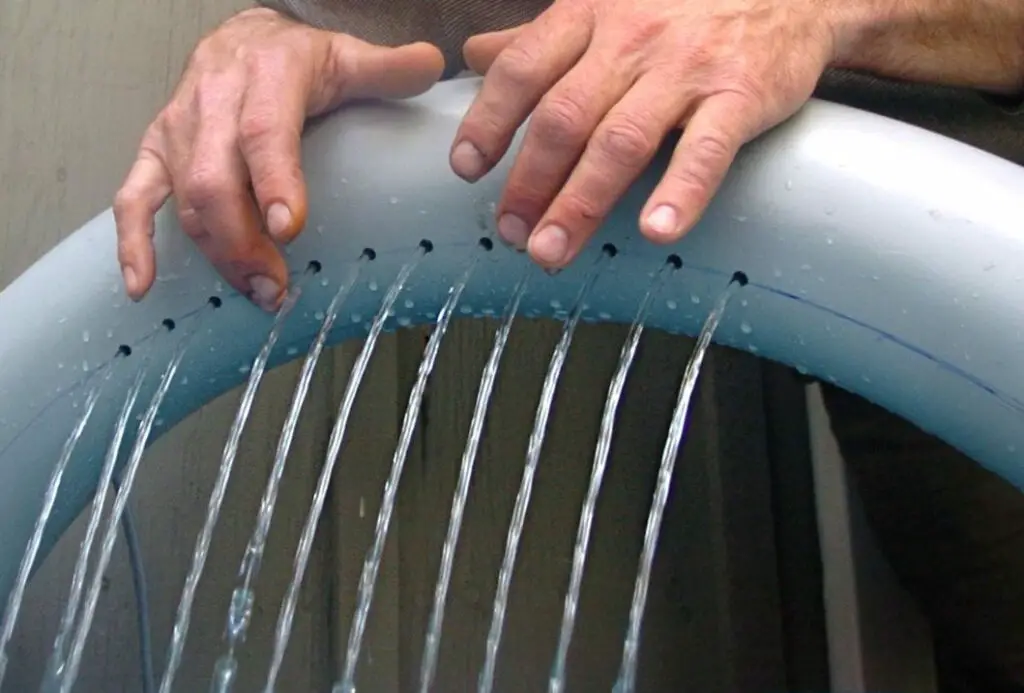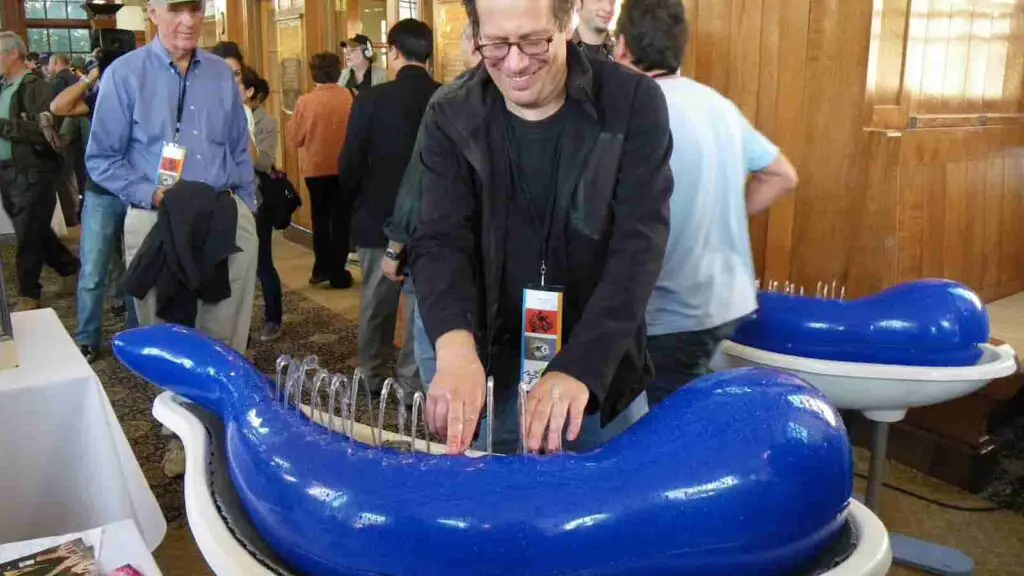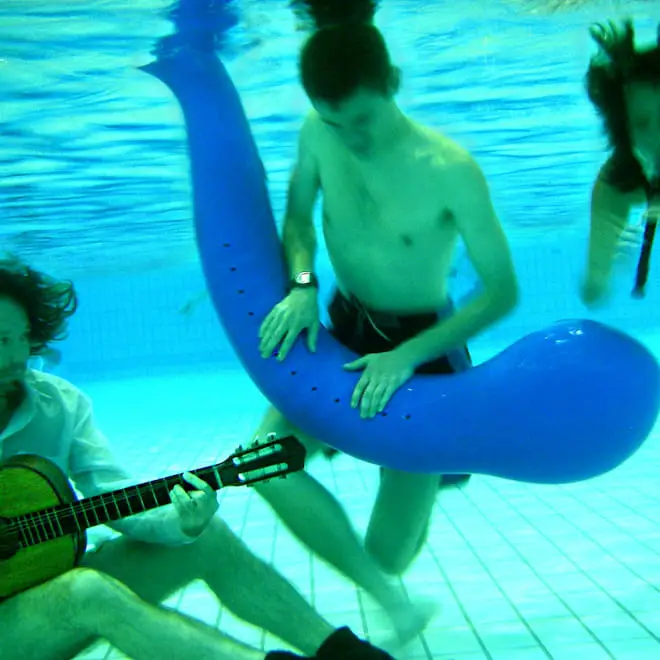A hydraulophone is a unique musical instrument that makes sound from vibrations in water.
A hydraulophone is a musical instrument that produces sound by using water to generate and manipulate vibrations. It is an interactive instrument that allows players to create music by pressing their fingers against water jets or other water sources.
The hydraulophone typically consists of a series of water jets or nozzles, similar to small fountains, arranged in a particular pattern. Each jet produces a different pitch or tone when water is flowing through it. By blocking or altering the flow of water with their fingers or other objects, players can control the pitch and volume of the sounds produced.
Hydraulist and composer Ryan Janzen, playing with Hart House Symphonic Band.

The hydraulophone is unique among musical instruments because it combines elements of both wind and string instruments. When a finger is placed over a water jet, it creates a similar effect to covering a hole on a wind instrument, changing the pitch. The flowing water also creates a vibrating column, similar to a vibrating string on a string instrument.
Who Invented the Hydraulophone?
The hydraulophone was designed by the “Father of Wearable Computing,” Dr. Steve Mann from Canada. Dr. Mann is an electrical and computer engineer and inventor who created the Digital Eye Glass, an early form of Google Glass.
Dr. Mann created the first hydraulophone in 2005 and patented the instrument in 2011.

According to Dr. Mann, he personally has created over 100 unique hydraulophones.
Who Can Play the Hydraulophone?
Anyone with at least one finger is able to play the hydraulophone, and knowing how to read music or how instruments produce sound is not necessary.
Hydraulophones can be found in several museums, universities, water parks, and theme parks across the US, Canada, Australia, and Denmark. You can find and try out the hydraulophone at the following locations:
- Thinkery Children’s Museum in Austin, Texas
- Chicago Children’s Museum in Chicago, Illinois
- Ontario Science Centre in Toronto, Ontario, Canada
- Experimentarium in Copenhagen, Denmark
- Legoland California in Carlsbad, California
- Baylor University in Waco, Texas
- Sydney Olympic Park Aquatic Centre in Sydney, Australia
- University of Toronto in Toronto, Ontario, Canada
- African Lion Safari in Toronto, Ontario, Canada
The world’s largest hydraulophone is located at the Ontario Science Centre

How Do Hydraulophones Work?
Traditional acoustic instruments produce sound by the manipulation of matter. There are three primary states of matter: solid, gas, and liquid.
String and percussion instruments (including the harp and piano) produce sound when a solid surface or string is hit/plucked.
In contrast, woodwind and brasswind instruments produce sound by pushing your breath, a gas, through the instrument’s body.
The hydraulophone works using the final state of matter, liquid which makes hydraulophones an entirely new category of musical instruments.



A hydraulophone works by pumping water through a horizontally oriented curved tube with small holes on the top of the tube. The holes on the top of the tube release water like a water fountain or a Slip N Slide.
To play a hydraulophone, you will place a finger over one or more of the holes, like playing a clarinet. Covering the hole forces the water to redirect itself, and it passes over what is known as a “sounding mechanism.” The type of sounding mechanism will vary depending on the type or materials used in manufacturing.
The purpose of the sounding mechanisms is to produce an audible tone using the vibrations of the redirected water. Below is the inner workings of a hydraulophone and a technical diagram of how the sound is produced.
What a hydraulophone looks like inside the tube body

Hyraulophone Embouchure
If you play a woodwind or brass wind instrument, then you know how important your embouchure is when you play. The embouchure is the position and shape of the lips and tongue on the mouthpiece of the instrument.
A too-tight embouchure makes it hard for a reed to fully vibrate or enough air to pass into the body of a horn, but if the embouchure is too loose, the breath escapes past the mouthpiece producing a faint or no sound at all. While there is no mouthpiece on a hydraulophone, the embouchure is still essential.
When playing the hydraulophone, your fingers take the place of your lips on a woodwind instrument.
The hydraulophone’s sound is able to be modified based on the position of your fingers over the holes as well as the pressure. A hydraulophone will produce a different sound if you place your finger over a hole from the top or if you slide/lean the side of your finger on the holes.
You can cover the entire hole or cover half of one to get new sounds.
TIP: When you play around on the instrument first listen to the differences in sound when you use your finger embouchure at first. Take a look at the video below to see someone playing the hydraulophone (you might need to turn up your volume to hear the music clearly).
Types of Hydraulophones
There are two primary versions of hydraulophones, the 12-jet diatonic hydraulophone, and the 45-jet chromatic/concert hydraulophone.
The 12-jet diatonic hydraulophone is the most common version, and this has 12 water jets in a row which correspond with the 12 notes that the instrument is capable of playing.
The 12-jet hydraulophones have a range of one and a half octaves starting with A below middle C and extending up to E. Examples of the 12-jet diatonic hydraulophone would be the Nessie hydraulophones.

The Clarinessie is called “the Nessie” because it resembles the Loch Ness Monster. A Nessie hydraulophone is usually brightly colored with one enlarged end with an opening that looks like a mouth.
The other end of Nessie has an extra curve that looks like a tail. These tadpole-looking instruments are attractive to children, which encourages interaction and engagement with music during play.
According to Mann, the inventor of Nessie, when he was creating the hydraulophone, his 4-year-old daughter would drape a blanket over Nessie at night. She would tell her dad, “I don’t want her to get cold,” which is an adorable story but shows how children are drawn to this water instrument.

The other kind of hydraulophone is the 45-jet chromatic/concert hydraulophone.
Note: Hydraulophones installed at parks and water parks are usually the 12-jet diatonic version, while the 45-jet chromatic hydraulophones are considered concert or professional instruments.
These hydraulophones have a 3.5-octave range that spans from “A to E, chromatic, plus an additional A-flat below the lowest A.” As the name implies, the 45-jet hydraulophones have 45 water jets, which means they can produce 45 different musical notes/tones.
At the present time, the only 45-jet hydraulophone accessible to the public is located at the Ontario Science Center in Canada, and it is the world’s largest hydraulophone as well.
Above and Below Water
What makes the hydraulophone unique is that while public installations of hydraulophones are all above water, the instrument can be played completely submerged underwater.
Water distorts sounds, and you experience this distortion when swimming with your head and ears underwater and someone is shouting or talking outside of the water. You can hear something, but it’s fuzzy and muffled.
Hydraulophones that are designed to be played underwater use a specialized speaker and microphone system to project the sound through the water and even through glass.

The Danish ensemble, Between Music is a musical ensemble and performance art group that plays music using new instruments and in unique environments like being fully submerged in water. The group has studied instruments and are musicians with knowledge of physics and how an instrument can be used.
They play drums underwater, and the group’s artistic director/composer/performer Lila Skovmand plays the hydraulophone and sings with the group underwater.
Note: The group’s performances and recordings of original music are by far one of the most fascinating processes for creating music. If you play an instrument or want to see something incredibly cool, check out the video below about Between Music and how their hydraulophone works.
(Check out their other videos of the artists explaining how they play and sing underwater. It really makes you think and view music in new ways).
Hydraulophones for Disabilities & Music Therapy
Since hydraulophones use water jets, the spray caused by placing fingers over the holes can make seeing note names written on the instrument’s body a challenge above water.
When playing underwater, visibility is poor and distorted. This is why many hydraulophones will have Braille printed on them. There is a one-to-one correlation between letters and numbers when playing a standard 12-jet hydraulophone. This means that Jet 1 is A, Jet 2 is B, Jet 3 is C, Jet 4 is D, etc. The tactile and sensitivity of touch that is needed to read Braille is similar to playing the hydraulophone.
It is not rare for deaf musicians to exist; Beethoven began losing his hearing around 28 and was completely deaf by 44 or 45 years old. He was able to feel the different vibrations the piano would produce when played which allowed him to compose and play complex music.
Feeling the force, frequency, and sensation of sound vibrations provides a unique experience for deaf or hard-of-hearing musicians.
Scottish percussionist Dame Evelyn Glennie has been profoundly deaf since the age of 12, and she often speaks about hearing music in other ways, like through vibrations.
She was given the opportunity to try playing the hydraulophone by the creator Steve Mann in 2007.
“She loved the hydraulophone because she can feel the vibrations. The human body is mostly made of water, so to have the sound vibrating in water and touching your fingers brings you the sound in a non-cochlear sort of way.”
– Steve Mann
Check out the video of Steve Mann demonstrating the hydraulophone to Dame Evelyn Glennie below.
Music therapy is a form of therapy that can be used to help patients improve communication, express emotions (including individuals who are non-verbal), reduce stress levels, facilitate pain management, and promote physical rehabilitation.
Hydraulophones are making their way into music therapy practices because it is another tool for patients. The instrument combines water and music’s physical and emotional elements and can be used outside of a hospital. Therapists can bring hydraulophones with them into a patient’s home, nursing home facilities, and retirement homes.
The hydraulophone does not require strength to hold or play the instrument, meaning anyone can play it. Plus, it is fun to play music, and doing that with music is a new experience that can bring joy and interactions to individuals who may not experience those things every day.
How Much Do Hyraulophones Cost & How to Buy One?
Hydraulophones are not standard musical instruments that you will see in a band room or onstage at an orchestral performance. These instruments allow us to question what music is and how it is able to be created in non-traditional ways.
Finding a hydraulophone for purchase can be a challenge or near impossible as it is not a widely available or commonly sought-after musical instrument. The availability and specific places to buy a hydraulophone are often unclear.
The cost of hydraulophones can vary significantly depending on which type it is as well as other factors such as craftsmanship, materials, and design complexity, making it difficult to pinpoint an exact price range.
Due to these factors, potential buyers may need to engage in extensive research, reach out to the inventor himself, and explore different avenues to uncover where to purchase a hydraulophone and determine its cost.
There are instructions online to create a simple hydraulophone (this involves tools, electricity, and water, so it should be done with the help of a parent or guardian for safety purposes) if you want to try making your hydraulophone.
If you visit any of the listed museums or water parks in this article, make sure to make a point to stop and try out the hydraulophone for yourself.
Disclaimer: This post may contain affiliate links. We only recommend high-quality products that are used and recommended by real musicians. If you use these links to buy something we earn a small commission.
